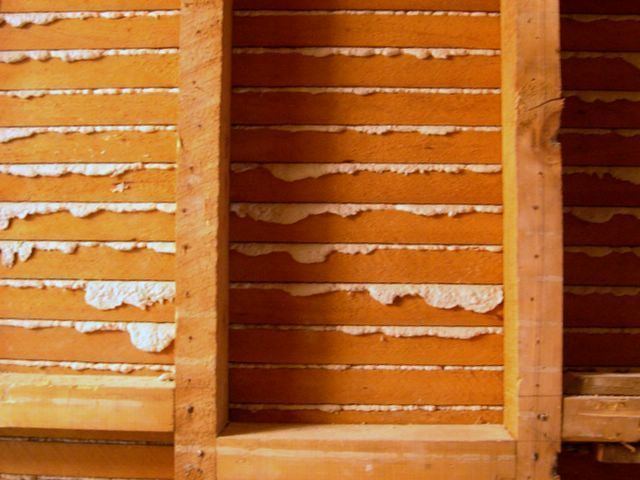 | ||
A lath or slat is a thin, narrow strip of straight-grained wood used under roof shingles or tiles, on lath and plaster walls and ceilings to hold plaster, and in lattice and trellis work.
Contents
Lath has expanded to mean any type of backing material for plaster including a metal wire mesh or expanded metal that is applied to a wood or metal framework as matrix over which stucco or plaster is applied and wallboard products called gypsum or rock lath. Also reed mat was historically a lath material. One of the key elements of lath, whether wooden slats or wire mesh, are the openings or gaps that allow plaster or stucco to ooze behind and form a mechanical bond to the lath where gypsum lath relies more on a chemical bond.
Etymology
The word is recorded from the late 13th century and is likely derived from the Old English word *læððe, a variant of the word lætt. This in turn would seem to stem from a Proto-Germanic word *laþþo, from which have sprung words in many Germanic languages, e.g. Dutch lat, German Latte; the root has also found its way into Romance languages, cf. Italian latta, French latte, and is related to German lade, laden denoting a board, plank, sash, shutter, counter and hence also a shop.
Gypsum lath
Gypsum lath (rock lath) consists of gypsum plaster sandwiched between two sheets of absorbent paper, the finish side treated with gypsum crystals for the plaster to chemically bond to and sometimes perforated to allow mechanical bonding. It was improved in 1910 by the paper wrapping the edges and multiple variations were developed in the 1930s. Gypsum lath is commonly used in place of wood since it is noncombustible, easy to use, and gives better results. The popularity of the lath and plaster method declined in the 1950s, as it was replaced by the less expensive drywall method. Gypsum lath is available with a foil facing which acts as a vapor barrier and heat reflector, and as a veneer base for plaster veneer.
Wood lath
Today, wooden-slat laths are still used in building construction to form a base or groundwork for plaster but modern lath and plaster applications are mostly limited to conservation projects.
Historically there were three ways of making wood lath for plaster: 1) Riven lath is the stronger forerunner to sawn lath, as it was traditionally split with the grain from chestnut, oak, or similar hardwoods or softwoods like eastern white pine. Individual laths were riven and nailed in place; 2) Accordion lath are thin, sawn boards partially split with a hatchet or axe and the splits spread apart to form gaps for the plaster to key into. The spreading action is like an pulling an accordion open thus the name; 3) After the circular saw came into use in the early 19th century lath for plastering was sawn in sawmills and delivered to the building site.
Sometimes the laths need to be held off of a solid surface so the plaster can wrap around the lath. Single pieces of lath applied to a surface for this purpose are sometimes called counter lath.
Laths were also used to fix reed to a timber structure before plastering.
Tiles, slates, and other coverings on roofs and walls are often fastened to laths, sometimes also called battens or slats. Such strips of wood are also employed to form lattice-work, or are used as the bars of venetian blinds, and window shutters.
Lath is also used on many tobacco farms in the Connecticut Valley as a means to carry and hang the plant in barns. This is achieved by using one of two methods, hooking or spearing. A "spear" lath is just a regular lath that is held in an upright position, the worker then mounts a spear on top and "spears" the tobacco onto the lath. The other form of lath is called Hook Lath, which just has small hooks attached that allows a worker to hook the stems of tobacco plants onto the lath. Also, lath cut from spruce or balsam fir trees were used for building wooden lobster traps.
Counter-lath
Counter-lath is a term used in roofing and plastering for a piece of wood placed perpendicular to the lath. In roofing a counter-lath is a slight piece of timber parallel with and between common rafters to give the lath extra support or "a lath placed by eye between every two gauged ones." In plastering a counter lath is placed perpendicular to the lath as a fillet (a thin, narrow strip of material) to space the lath off of the surface to allow the plaster to pass through the lath and key (mechanically bond) to the lath.
Metal lath
Metal lath dates from the late 19th century and is used extensively today with plaster and stucco in home and commercial construction. In these applications the lath adds strength and rigidity in addition to providing a matrix to which the stucco can adhere. This is similar to the way rebar is used to strengthen some concrete and masonry applications.
Metal lath is made by slitting and pulling apart a sheet of metal so it is expanded or by welding or weaving wires together in a variety of types which are painted or galvanized to prevent corrosion:
